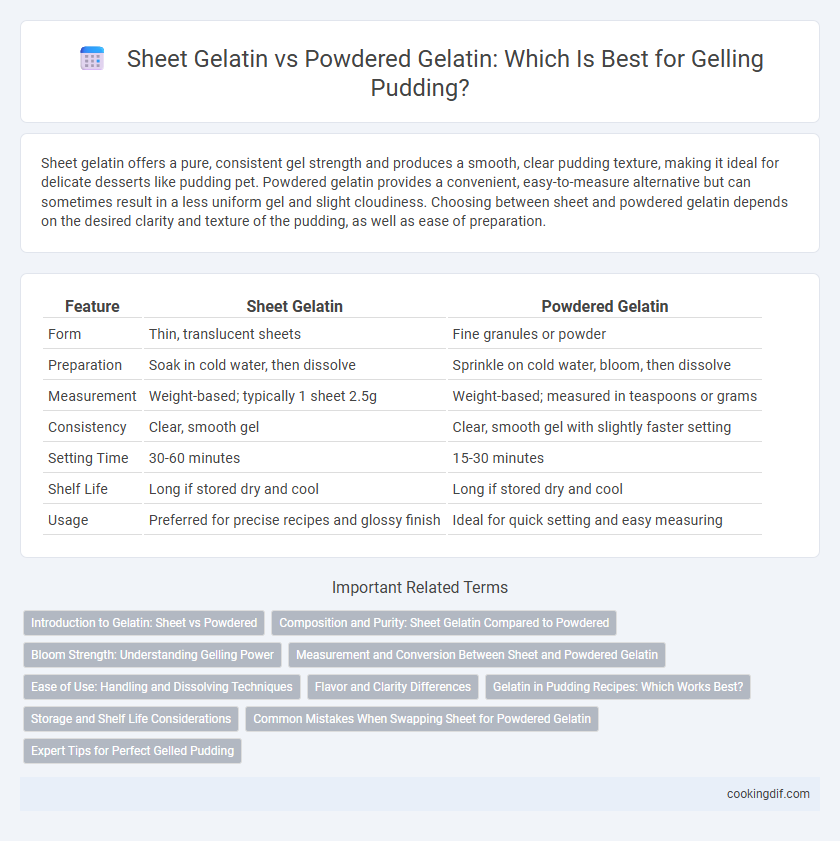Sheet gelatin offers a pure, consistent gel strength and produces a smooth, clear pudding texture, making it ideal for delicate desserts like pudding pet. Powdered gelatin provides a convenient, easy-to-measure alternative but can sometimes result in a less uniform gel and slight cloudiness. Choosing between sheet and powdered gelatin depends on the desired clarity and texture of the pudding, as well as ease of preparation.
Table of Comparison
| Feature | Sheet Gelatin | Powdered Gelatin |
|---|---|---|
| Form | Thin, translucent sheets | Fine granules or powder |
| Preparation | Soak in cold water, then dissolve | Sprinkle on cold water, bloom, then dissolve |
| Measurement | Weight-based; typically 1 sheet 2.5g | Weight-based; measured in teaspoons or grams |
| Consistency | Clear, smooth gel | Clear, smooth gel with slightly faster setting |
| Setting Time | 30-60 minutes | 15-30 minutes |
| Shelf Life | Long if stored dry and cool | Long if stored dry and cool |
| Usage | Preferred for precise recipes and glossy finish | Ideal for quick setting and easy measuring |
Introduction to Gelatin: Sheet vs Powdered
Gelatin, a key gelling agent derived from collagen, comes in two primary forms: sheet and powdered. Sheet gelatin, often preferred by professional chefs, offers precise control over bloom strength and is dissolved by soaking in cold water before use. Powdered gelatin, more common in home kitchens, is versatile and easy to measure but varies in bloom strength and requires careful blooming in liquid to ensure consistent gelling results in pudding preparation.
Composition and Purity: Sheet Gelatin Compared to Powdered
Sheet gelatin boasts a higher purity level than powdered gelatin, as it is produced through a more refined extraction process, resulting in a clear and odorless product ideal for delicate pudding textures. Its composition involves purified collagen sheets with consistent bloom strength, ensuring precise gelling and superior clarity in desserts. Powdered gelatin often contains fillers and may vary in bloom strength, which can affect the consistency and visual quality of puddings.
Bloom Strength: Understanding Gelling Power
Sheet gelatin offers a more consistent Bloom strength compared to powdered gelatin, ensuring precise gelling results in puddings. Bloom strength measures the gel's firmness and is crucial for achieving the desired texture and stability. Using sheet gelatin with a specified Bloom rating allows for controlled gelling power, making it ideal for delicate pudding preparations.
Measurement and Conversion Between Sheet and Powdered Gelatin
Sheet gelatin and powdered gelatin differ in form but can be precisely converted for accurate gelling results; one sheet typically equals about 2.5 grams of powdered gelatin. For recipes, 1 tablespoon of powdered gelatin corresponds roughly to 6 sheets, allowing consistent texture and firmness in pudding preparation. Accurate measurement ensures proper gel strength, with 1 gram of gelatin setting approximately 100 milliliters of liquid, critical for achieving the desired pudding consistency.
Ease of Use: Handling and Dissolving Techniques
Sheet gelatin offers precise control with consistent Bloom strength, requiring soaking in cold water before dissolving gently over low heat, ensuring smooth gel texture without clumps. Powdered gelatin demands careful sprinkling over cold liquid to prevent lumps, then dissolving through gentle warming, making it more prone to uneven hydration if mishandled. Both forms need attention to temperature and timing, but sheet gelatin's pre-measured sheets often simplify handling and guarantee uniform gelling results in pudding recipes.
Flavor and Clarity Differences
Sheet gelatin provides superior clarity and a cleaner flavor profile in puddings due to its high purity and absence of additives, making it preferred for delicate desserts. Powdered gelatin often contains fillers that can slightly dull the pudding's transparency and introduce a mild off-flavor. Using sheet gelatin results in a smoother texture and enhances the overall visual appeal, preserving the pudding's intended taste nuances.
Gelatin in Pudding Recipes: Which Works Best?
Sheet gelatin and powdered gelatin both effectively create the smooth, creamy texture desired in pudding recipes, though their differences impact ease of use and consistency. Sheet gelatin, prized for its pure, neutral flavor and precise gelling strength, requires soaking in cold water before melting, ensuring a clear, consistent gel ideal for delicate pudding desserts. Powdered gelatin, more commonly available and convenient, dissolves quickly after blooming, but varying bloom strengths can affect the firmness and texture of the pudding, making it essential to adjust quantities for optimal results.
Storage and Shelf Life Considerations
Sheet gelatin offers a longer shelf life when stored in a cool, dry place compared to powdered gelatin, which tends to absorb moisture more readily and may clump over time. Proper storage of sheet gelatin in an airtight container helps maintain its gelling strength and extends usability for up to two years, whereas powdered gelatin typically remains effective for about one to two years if kept sealed away from humidity. Both types benefit from protection against heat and light to preserve their gelatinization properties for pudding preparation.
Common Mistakes When Swapping Sheet for Powdered Gelatin
Common mistakes when swapping sheet gelatin for powdered gelatin include incorrect conversion ratios, as one sheet typically equals about one teaspoon of powdered gelatin, which can affect the gelling strength and texture. Over- or under-hydrating powdered gelatin also leads to inconsistencies; powdered gelatin requires blooming in cold water before heating, whereas sheets are soaked and squeezed to the right moisture level. Failing to adjust for these differences causes puddings to be either too firm or too runny, compromising the desired silky, smooth consistency.
Expert Tips for Perfect Gelled Pudding
Sheet gelatin offers more precise control over gel strength and clarity, making it ideal for achieving a smooth, perfectly set pudding. Expert tips recommend blooming sheet gelatin in cold water before gently dissolving it to prevent lumps and ensure consistent gelling. Powdered gelatin can be used as a convenient alternative but requires careful measurement and thorough blooming to avoid uneven texture in the final pudding.
Sheet gelatin vs Powdered gelatin for gelling Infographic

 cookingdif.com
cookingdif.com